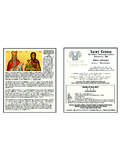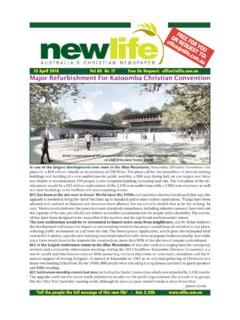Transcription of Elder’s Induction Course - Adventist Church in UK …
1 elder s Induction Course Ministerial, Elders and Diaconate ministries British Union Conference of Seventh-day Adventists Stanborough Park, Watford, Herts WD25 9JZ January 2016 Dear elder , Welcome to your new and noble role as one of the overseers or elders of God s family. The enclosed material has been put together to help equip you for service to the flock over which you share the responsibility of leadership. It is by no means exhaustive but rather an easy guide and introduction to the skills and knowledge that an elder needs to operate effectively. The material covers seven areas as follows: 1. Preaching 2.
2 Governance and Procedures 3. Church History 4. Visitation Skills 5. Transformational Character 6. Core Theology 7. Keeping the Church Family Safe It would be best if you went through the material with your pastor or another experienced elder and in the case of the Visiting Skills module, with a team of people who will also be visiting the members and visitors. Some of the material is very practical and some more informative. Much more could have been included in the Course but it is our hope that the material will whet your appetite for more learning and courses that will help you progress in excellence in the ministry of being an elder . The last page of this material will provide you with links and ideas for resources.
3 May the Good Shepherd bless you as an under-shepherd. Llewellyn Edwards BUC Ministerial, Elders and Diaconate department of the British Union Conference January 2016 We are indebted to a number of individuals whose materials have contributed to the content of this Course among them are Pastor Patrick Boyle, Mr Godwin Benjamin and Pastor Cyril Sweeney. elder s Preaching Course Work through the A to J sections below. Respond to the exercises after each section and then sit down with your pastor, mentor, or another experienced preacher and discuss your answers. A) CONSIDER THE CONGREGATION 1. How are they made up? Old, young, male, single, married?
4 White, black Romanian, Nigerian, etc. 2. What do they expect when they come to Church ? 3. What do they need? 4. What do they see? Preacher? Church ? 5. What are some things which might have a negative effect upon them? 6. What things might have a positive influence? 7. What are some things we should consider to do well? [For instance Smile, warm handshakes, appearance, etc] Exercise: The next time you are at your Church answer the above questions and share your observations with your mentor. B) PREACHING TO YOUTH They are looking for answers and direction in life. Sex, Lifework, Creation and Evolution. Morals - right and wrong. Origins relationship identity.
5 They are often badly served by preachers in these areas. They need a cause to belong to and which challenges and inspires them. They need a personal God who is their Creator, delights in them, and counts them as His son or daughter. Exercise: Make a list of how the beliefs of the Adventist Church address the above issues. Talk them over with your mentor or the Church Youth Leader. C) GENERAL HINDRANCES TO EFFECTIVE PREACHING I. Talking about yourself. Your latest holiday, aches, pains etc. 2. Beginning with apologies. You have been rushed. You have been asked to preach at the last minute. 3. A long introduction to your subject 4. General comments about the weather, the music, the special guests, the Church announcements etc 5.
6 Excessive piety. Long prayers before you begin. 6. Telling the congregation you have four or seven points in your sermon. If you are boring after point two the tego [their eyes glaze over] factor kicks in and you have lost the congregation. 7. Hobby horses. Your special subject using Ellen White quotes to support your view. 8. Beginning with a quotation. 9. Excessive humour. 10. Same sermon in a different dress. 11. Poor vocal communication. Speaking too fast, too slow, stumbling over words, poor pronunciations. See the speech exercises below [Section K]. 12. Criticism, bigotry. 13. Your deportment in the pulpit. Dress, bare feet etc. Don t call attention to yourself.
7 You are there to uplift Christ. 14. Disorganization. See that the music, mikes, lights, Power Points are ready for use before you go onto the pulpit. 15. Lack of study and preparation. 16. Do not let others read the Scripture unless they are well prepared. Poorly read Scriptures mean it isn t important. 17. Give people time to find the text. 18. Pray short not long, boring prayers. Exercise: Talk the list through with your pastor. D) WHEN PEOPLE ARE OPEN TO CHANGE It is recognized that there are five situations in a person's life when they are most likely to be open to God. 1. In early youth 2. In old age 3. In a time of transition and trouble 4.
8 Through friendship 5. Hearing the Gospel preached Are there any persons in the Bible whom you can identify who might fit into these categories? Example: In trouble - The Prodigal Son. Exercise: Make a list of Bible passages that speak to these five situations and explain how they do that to your mentor. E) WHAT PREACHING IS NOT 1. It is not standing in the pulpit and talking. 2. It is not a lecture. 3. It is not a person standing in the pulpit and telling people their personal beliefs. Even if it is shouted at them. 4. It is not information transfer, passing information from one person to another. 5. It is not lecturing people and telling them what they should believe or how they should behave.
9 6. It is not a person standing in the pulpit and displaying their learning or ignorance. 7. It is not a power point presentation as a substitute for preaching. 8. It is not a talk interspersed by slides or video clips. 9. It is not a series of stories strung together which entertain a congregation. 10. It is not repeating pointlessly Scripture passages without exposition. Exercise: Explain why these are not preaching to someone else. If we can say what preaching is not, can we attempt to say what it is? F) WHAT IS PREACHING? It is an experience Involving: The Preacher The Congregation The Divine The Demonic Its purpose is to: Encourage and persuade the Mind and Heart of man To unite with the Heart and Mind of God into a saving fellowship Exercise: Talk this section through with your pastor or mentor.
10 G) SERMON STRUCTURE A Sermon Is Like A Fish It has a head It has a body It has a tail It is vital that the Head - the Introduction, and the Tail - the Conclusion, are in proper proportion, that is not too far apart. The Body must not be too fat, too thin, too long, too bloated, but full with nourishing food, that is the gospel. Exercise: Discuss this with your pastor or mentor. H) PUTTING THE SERMON TOGETHER The most difficult part of preaching is knowing clearly what you want to say to the congregation or what you want them to know, believe or do. Exactly what is your message? If you cannot write it down in a sentence or two, then you do not know clearly what you want to say.




